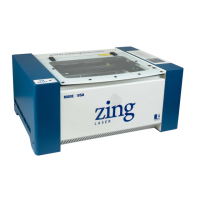Section 7: Using the Epilog Dashboard
91
In Basic mode we interpret dots in a couple of different ways depending on the
type of artwork that is being used:
1. If the image being engraved is black and white, the laser fires wherever
there is black.
2. If the image is a grayscale image (photograph or clipart) or a color, the laser
fires wherever there is a black dot. Grayscales are defined in percentages of
dot density (also known as dot spacing). A 10% gray has one black dot for
every ten available dot spaces and produces an engraving pattern with
widely spaced dots. A 50% gray has 5 black dots for every ten available
spaces and produces a pattern with a higher dot density. Colors are
interpreted as shades of gray, where darker colors (red for instance)
correspond to darker shades of gray and lighter colors (yellow) correspond
to lighter shades of gray. A box with a 10% fill (left side in diagram below)
and a box with a 50% fill (right side) are shown:
When you place different shades of gray next to each other it produces a rich and
complex look that makes laser engraving so attractive. You can see this in many
of the samples we produce. The lighter shades of gray tend to be better for
producing nice images. Many users will place a 10% fill next to a 30% or 40%
fill. Gray shades over about 50% or 60% are so dense that they start to run
together and begin to look like the color black is being used.

